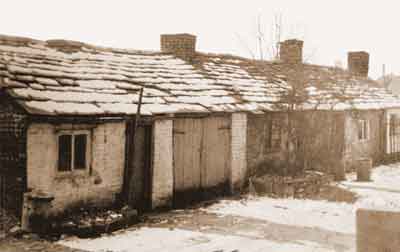Fletcher St, off Stockport Rd, Denton
These workshops were situated on the west side of Fletcher St, directly behind four coal miners' cottages on Stockport Rd.
The building was a single-storey brick-built structure with a stone-flag roof. There were four chimneys, the outer ones being in the gables. It was divided into four planking rooms with the two westerly ones being about half the width
of the two easterly ones. The planking process required a steady supply of hot water contained in a large open vessel called a 'kettle', hence, each chimney vented a hearth used to heat water.

Hats were traditionally made of felt, which is a non-woven cloth. To do this a conical-shaped hood was made from wool or fur. A hood was made by joining two triangular pieces of material together, called ‘bats’. Two bats were then taken and laid on top of each other, separated by a piece of damp cloth or leather. Two edges of each bat were then teased together, thus joining them to form a cone-shaped hood. This hood was then ready for the second stage of hat manufacture, which was 'planking' and this turned the material into felt.. Planking involved immersing a hood in a ‘kettle’, containing hot water and sulphuric acid with the addition of poisonous mercurous nitrate (HgNO3). The procedure was to alternately dip the hood into the kettle and then roll it on a plank with a planking pin (aka a hatter's pin). A planking pin was a wooden rolling pin with pointed ends. This gradually shrank and thickened the material in the hood to make it suitable for making into a hat.
During the planking procedure workers, known as ‘plankers', faced mercury poisoning caused by inhaling vapour from the kettle. The effects of poisoning suffered by plankers as a result of the use of mercurous nitrate gave rise to the expression, ‘to be as mad as a hatter’.
After planking, the next stage was to form the hood on a wooden hat block of the required shape, after which it was stiffened, dyed to the required colour, and dried. It was then ready for the finishing processes to turn it into a hat.
Planking Kettle
Referring to the above engraving, positioned around the kettle are six sloping hard-wood planks for use by up to six plankers.
Each planker dipped a hood into the kettle, then pulled it out and rolled it on the plank with a planking pin.
After a period of dipping, rolling, and turning, the hoods were reduced in size and thickened as the material was converted into felt.
The finished hoods were of strong, seamless felt ready for the next stages of hat manufacture.
A surviving planking workshop
This is situated on the south-west side of Joel Ln, Gee Cross, Hyde. This is a single-storey, stone-built workshop with a slate roof.
The rear (western) elevation has four small rectangular windows, for steam ventilation, and a larger square window at the northern gable end where there is a chimney.
The workshop was originally divided into two rooms, the larger southern room was used for planking while the smaller northern room may have been used for drying the hat hoods.
This workshop is listed Grade II, List Entry No. 1068084, and it is designated as a hat maker’s workshop.